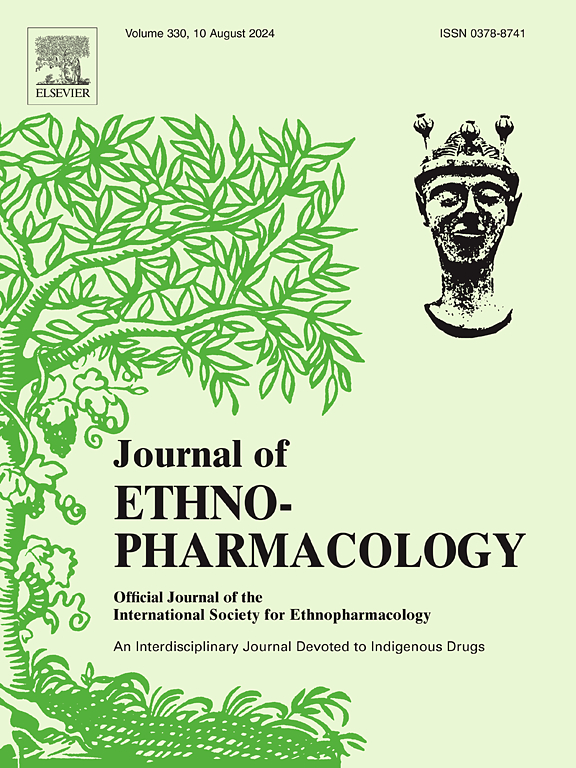Characterization and evaluation of Achillea erba-rotta subsp. moschata (Wulfen) I. Richardson and Achillea millefolium L. as potential ingredients for skin applications
IF 5.4
2区 医学
Q1 CHEMISTRY, MEDICINAL
引用次数: 0
Abstract
Ethnopharmacological relevance
Despite their different geographical distribution Achillea millefolium L. and Achillea erba-rotta subsp. moschata (Wulfen) I. Richardson are characterized by a consolidated traditional knowledge. Although this is not their first traditional use, they have also long been used as ingredients for skin healing and skin care.
Aim of the study
The aim of this work was to characterize the two Achillea species from a chemical and biomolecular point of view in order to find a simple tool for their discrimination. At the same time, the biological activity of the extracts as inhibitors of the enzymes tyrosinase and elastase and as antimicrobial agents was evaluated.
Materials and methods
The biomolecular analysis was performed on the DNA region trnL-F. The hydroalcholic (EtOH50 %) extracts were quali-quantitatively characterized by HPLC-PDA-MS/MS and tested for their inhibitory effect on the enzymes tyrosinase and elastase as well as for their antimicrobial activity. Cytotoxicity towards human fibroblasts was tested to evaluate their safety for potential applications.
Results
Restriction Fragment Length Polymorphism (RFLP) analysis of the trnL-F DNA region was a useful tool for species discrimination. Both extracts are rich in polyphenols and showed moderate tyrosinase (26-5 %) and elastase (22-14 %) inhibitory activity at 17 μg/mL. They were also able to inhibit the growth of the bacteria and yeasts studied, generally exhibiting cytotoxicity to human fibroblasts at concentrations of 500 μg/mL or higher.
Conclusions
The hydroalcoholic extracts from the aerial parts of A. millefolium and A. erba-rotta subsp. moschata can be considered good candidates for the cosmetic and health sectors, also supporting the traditional use of these species in the treatment of skin diseases.

棘棘亚种的鉴定与评价。莫沙塔(武芬)I.理查德森和阿喀那千叶L.作为潜在的皮肤应用成分。
民族药理学相关性:尽管它们的地理分布不同,千叶阿喀琉叶和阿喀琉叶阿喀琉叶。理查森的特点是传统知识的巩固。虽然这不是它们的第一个传统用途,但它们也长期被用作皮肤愈合和皮肤护理的成分。研究目的:从化学和生物分子的角度对两种阿喀喇属植物进行鉴定,以期找到一种简单的鉴别工具。同时,对其作为酪氨酸酶和弹性酶抑制剂及抗菌活性进行了评价。材料与方法:对DNA trl - f区进行生物分子分析。采用HPLC-PDA-MS/MS对乙醇提取物进行定性定量分析,并检测其对酪氨酸酶和弹性酶的抑制作用及抑菌活性。对人类成纤维细胞的细胞毒性进行了测试,以评估其潜在应用的安全性。结果:trnL-F DNA区域的限制性片段长度多态性(RFLP)分析是物种鉴别的有效工具。两种提取物均含有丰富的多酚类物质,在17 μg/mL的浓度下,对酪氨酸酶(26-5%)和弹性酶(22-14%)具有抑制活性。它们还能够抑制所研究的细菌和酵母的生长,通常在浓度为500 μg/mL或更高时对人成纤维细胞表现出细胞毒性。结论:千叶麻和牛耳麻地上部水醇提取物具有良好的药理活性。莫夏塔可以被认为是化妆品和卫生部门的良好候选者,也支持这些物种在治疗皮肤病方面的传统使用。
本文章由计算机程序翻译,如有差异,请以英文原文为准。
求助全文
约1分钟内获得全文
求助全文
来源期刊

Journal of ethnopharmacology
医学-全科医学与补充医学
CiteScore
10.30
自引率
5.60%
发文量
967
审稿时长
77 days
期刊介绍:
The Journal of Ethnopharmacology is dedicated to the exchange of information and understandings about people''s use of plants, fungi, animals, microorganisms and minerals and their biological and pharmacological effects based on the principles established through international conventions. Early people confronted with illness and disease, discovered a wealth of useful therapeutic agents in the plant and animal kingdoms. The empirical knowledge of these medicinal substances and their toxic potential was passed on by oral tradition and sometimes recorded in herbals and other texts on materia medica. Many valuable drugs of today (e.g., atropine, ephedrine, tubocurarine, digoxin, reserpine) came into use through the study of indigenous remedies. Chemists continue to use plant-derived drugs (e.g., morphine, taxol, physostigmine, quinidine, emetine) as prototypes in their attempts to develop more effective and less toxic medicinals.
 求助内容:
求助内容: 应助结果提醒方式:
应助结果提醒方式:


